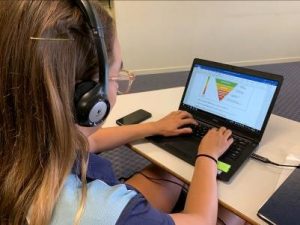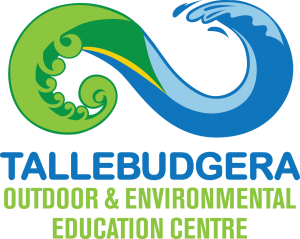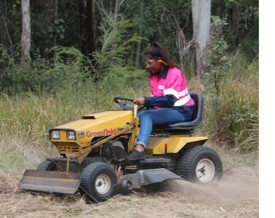FSK20119 Certificate II in Skills for Work and Vocational Pathways
 FSK20119 Certificate II in Skills for Work and Vocational Pathways is delivered in partnership with schools or alternative learning facilities as part of the Department of Education’s VET Pathways Program which is an agreement between First Nations Strategy and Partnerships and Tallebudgera Outdoor and Environmental Education Centre’s Registered Training Organisation. The program is targeted at but not limited to First Nations students.
FSK20119 Certificate II in Skills for Work and Vocational Pathways is delivered in partnership with schools or alternative learning facilities as part of the Department of Education’s VET Pathways Program which is an agreement between First Nations Strategy and Partnerships and Tallebudgera Outdoor and Environmental Education Centre’s Registered Training Organisation. The program is targeted at but not limited to First Nations students.
The purpose of the VET Pathways Program is to deliver Certificate courses to students across Queensland with the goal of increasing their employment prospects by attaining a Queensland Certificate of Education (QCE), learning in real world contexts, enriching cultural knowledge and connecting to community.
Units of Competency
The language, literacy, numeracy and digital technology Units of Competency that make up this course focus on five main themes – Work Health and Safety, Indigenous Cultural Knowledge, Working with Numbers, Career Planning and Digital Technology. Units of Competency are integrated to give them context and relevance. The assessment materials consist of a printed workbook and a short online course.
This course has significant benefits to students as it:
- contributes four QCE credits* and satisfies completed core requirements
- includes transferable workplace skills and knowledge
- builds students’ capability for workforce entry or vocational training pathways
- develops a greater understanding and respect for Aboriginal and Torres Strait Islander cultures which can assist with the reconciliation process.
* Four QCE credits will be awarded if at least 90% new learning is achieved (13 Units)
FSK20119 Certificate II in Skills for Work and Vocational Pathways is made up of the following 14 Units of Competency (1 Core Unit and 13 Electives) and all must be completed:
| National Code | Competency Title | Core/Elective |
| FSKLRG011 | Use routine strategies for work-related learning | Core |
| FSKLRG009 | Use strategies to respond to routine workplace problems | Elective Group B |
| FSKLRG010 | Use routine strategies for career planning | Elective Group B |
| FSKNUM012 | Use familiar and simple data for work | Elective FSK |
| FSKNUM014 | Calculate with whole numbers & familiar fractions, decimals & percentages for work | Elective Group A |
| FSKNUM015 | Estimate, measure and calculate with routine metric measurements for work | Elective Group A |
| FSKNUM019 | Interpret routine tables, graphs and charts and use information and data for work | Elective Group A |
| FSKOCM007 | Interact effectively with others at work | Elective Group B |
| FSKRDG010 | Read and respond to routine workplace information | Elective Group B |
| FSKWTG009 | Write routine workplace texts | Elective Group B |
| FSKDIG003 | Use digital technology for non-routine workplace tasks | Elective Group B |
| AHCOCM301 | Provide information on Aboriginal and/or Torres Strait Islander Peoples’ cultural practice | Elective Imported |
| AHCWHS202 | Participate in workplace health and safety processes | Elective Imported |
| PUACOM001 | Communicate in the workplace | Elective Imported |
Language, Literacy and Numeracy requirements
FSK20119 Certificate II in Skills for Work and Vocational Pathways is assessed at Level 3 on the Australian Core Skills Framework (ACSF). This means students will need to be able to read, write and calculate numeracy operations reasonably well (at about a Year 10 level). Schools are to provide the RTO with information regarding the students’ current LLN abilities which indicate whether the students will be able to complete the course successfully.
If students are not currently working at Level 3 on the ACSF, they will require additional time and a suitable LLN teacher to bring them up to the required literacy and numeracy level. The RTO can assist schools with developing a Training Plan that best caters for the needs of individual students.
Volume of Learning
The volume of learning of a Certificate II is typically 6 months – 1 year. The duration of the course will depend on the delivery model and the time allocated to learning each week. Schools may take 12 months to complete the course and additional time can be negotiated with the RTO if necessary. If the student already has the Foundation Skills at ACSF Level 3, the training may be accelerated and focuses on gap-training and contextual learning in the workplace.
Delivery Models
The course can be delivered to students within their school in a variety of ways depending on their geographic location, the needs of the students and the priorities of the school. This includes being delivered within the current timetable, delivered in one or more learning blocks or delivered in the student’s spare periods or other times they can be taken offline from their normal study program.
Whatever delivery model is selected, sufficient time and support must be provided for the student to engage fully with the program and to complete the required practical tasks and role plays.
Training and Assessment
Training and Assessment will remain the responsibility of the RTO. All training and assessment materials are provided and completed coursework must be returned to Tallebudgera Outdoor and Environmental Education Centre for final assessment. The student’s results will be reported to the Queensland Curriculum and Assessment Authority (QCAA) on completion of the course for inclusion on the student’s Queensland Certificate of Education.
No VETiS Funding
As Tallebudgera OEEC is a Queensland Government school, the RTO is not eligible to become a Skills Assure Supplier so is unable to provide services subsidised by the Department of Employment, Small Business and Training. This includes VET in Schools (VETiS) funding, the User Choice Program, apprenticeships or traineeships.
Course costs
Total costs per student for the qualification are as follows:
| Certificate II qualification – includes all printed or electronic learning materials and teacher resources, assessment of work, access to the online component and issue of the AQF qualification. | State Schools | Non-state schools |
| $350.00 | $400.00 |
How to enrol students
To enrol students or for more information about the course, please contact your Student Support Officer:
Roslyn Cridland
Senior Project Officer
Tallebudgera Outdoor and Environmental Education Centre RTO (Code 30685)
Ph: 5520 9316 ; Mobile: 0477 345 184; Email: rcrid2@eq.edu.au


 AHC21020 Certificate II in Conservation and Ecosystem Management is delivered in partnership with schools or alternative learning facilities as part of the Department of Education’s VET Pathways Program which is an agreement between First Nations Strategy and Partnerships and Tallebudgera Outdoor and Environmental Education Centre’s Registered Training Organisation. The program is targeted at but not limited to First Nations students.
AHC21020 Certificate II in Conservation and Ecosystem Management is delivered in partnership with schools or alternative learning facilities as part of the Department of Education’s VET Pathways Program which is an agreement between First Nations Strategy and Partnerships and Tallebudgera Outdoor and Environmental Education Centre’s Registered Training Organisation. The program is targeted at but not limited to First Nations students.